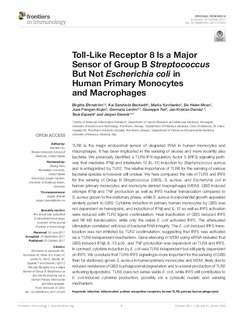| dc.description.abstract | TLR8 is the major endosomal sensor of degraded RNA in human monocytes and macrophages. It has been implicated in the sensing of viruses and more recently also bacteria. We previously identified a TLR8-IFN regulatory factor 5 (IRF5) signaling pathway that mediates IFNβ and interleukin-12 (IL-12) induction by Staphylococcus aureus and is antagonized by TLR2. The relative importance of TLR8 for the sensing of various bacterial species is however still unclear. We here compared the role of TLR8 and IRF5 for the sensing of Group B Streptococcus (GBS), S. aureus, and Escherichia coli in human primary monocytes and monocyte-derived macrophages (MDM). GBS induced stronger IFNβ and TNF production as well as IRF5 nuclear translocation compared to S. aureus grown to the stationary phase, while S. aureus in exponential growth appeared similarly potent to GBS. Cytokine induction in primary human monocytes by GBS was not dependent on hemolysins, and induction of IFNβ and IL-12 as well as IRF5 activation were reduced with TLR2 ligand costimulation. Heat inactivation of GBS reduced IRF5 and NF-kB translocation, while only the viable E. coli activated IRF5. The attenuated stimulation correlated with loss of bacterial RNA integrity. The E. coli-induced IRF5 translocation was not inhibited by TLR2 costimulation, suggesting that IRF5 was activated via a TLR8-independent mechanism. Gene silencing of MDM using siRNA revealed that GBS-induced IFNβ, IL-12-p35, and TNF production was dependent on TLR8 and IRF5. In contrast, cytokine induction by E. coli was TLR8 independent but still partly dependent on IRF5. We conclude that TLR8-IRF5 signaling is more important for the sensing of GBS than for stationary grown S. aureus in human primary monocytes and MDM, likely due to reduced resistance of GBS to phagosomal degradation and to a lower production of TLR2 activating lipoproteins. TLR8 does not sense viable E. coli, while IRF5 still contributes to E. coli-induced cytokine production, possibly via a cytosolic nucleic acid sensing mechanism. | nb_NO |

